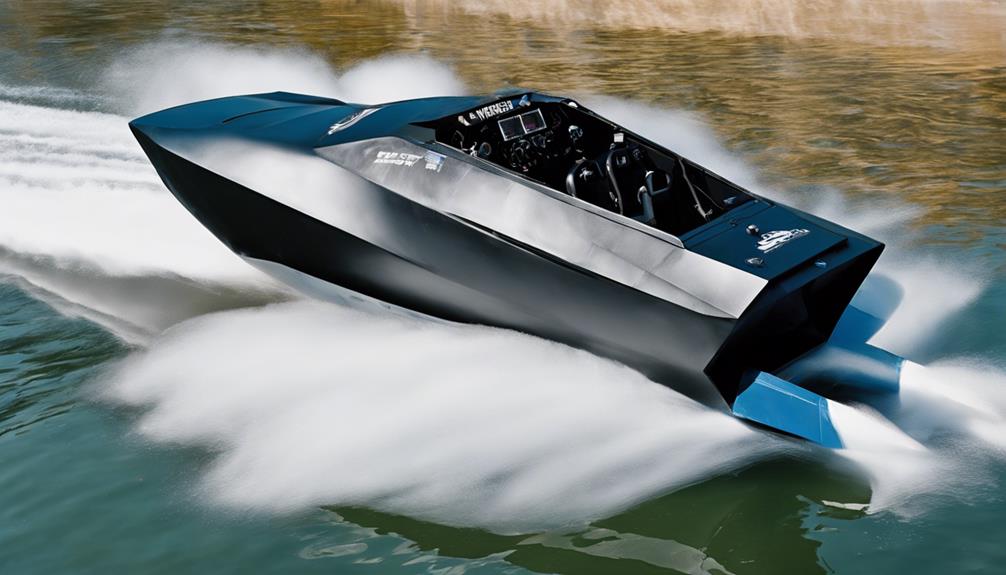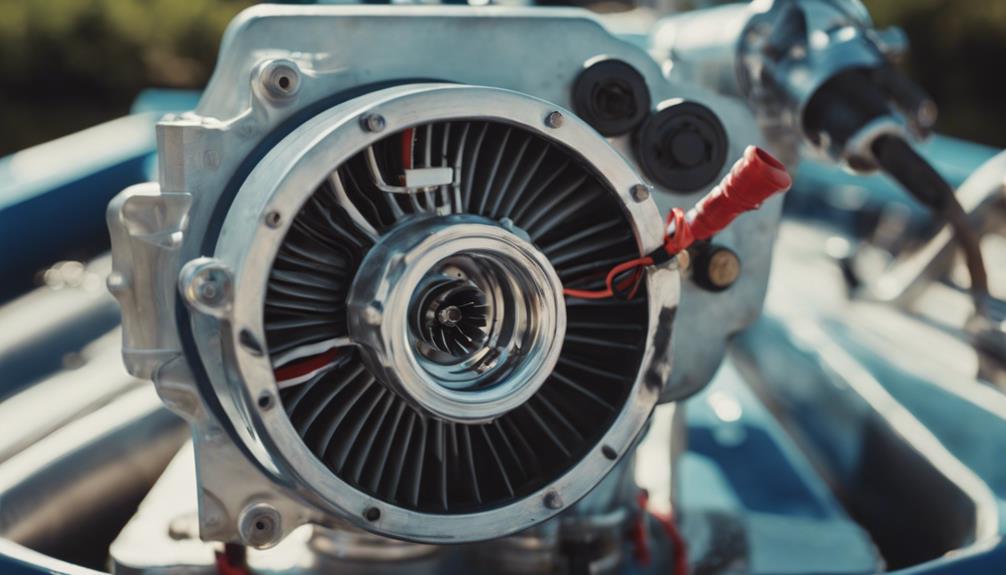When you're buying a jet boat, consider your intended use first, like fishing or family outings. Assess the boat's condition by checking the hull for damage and confirming interior comfort. Look into engine performance, including horsepower and maintenance history, to gauge overall reliability. Don't forget safety features like life jackets and operating lights. Inspect the jet pump and electrical system, as these are essential for function. Finally, verify the boat meets your storage needs. There's a lot more to explore to help you make the best choice for your dream jet boat.
Key Takeaways
- Assess the boat's condition by checking the hull for damage, interior wear, and structural integrity to ensure safety and performance.
- Verify engine performance through a compression test and inspect the impeller for damage to avoid costly repairs later.
- Check for adequate storage space and seating capacity to meet your intended use for fishing, wakeboarding, and family outings.
- Confirm the presence of safety features like life jackets, fire extinguishers, and operational navigation lights before making a purchase.
Intended Use and Requirements
When buying a jet boat, you should first pinpoint your primary activities—like fishing, wakeboarding, or family outings—to verify the boat fits your specific needs. Your intended use will dictate several vital features that the jet boat must have. For instance, if you plan on fishing, you'll want adequate storage space for gear and a layout that facilitates easy access to tackle.
On the other hand, if your focus is on wakeboarding, look for models that offer the right seating capacity and performance features to create a great wake. Don't forget to take into account the weight capacity of the boat. It's essential to ascertain it can accommodate both passengers and gear without compromising performance.
Additionally, research different types of jet boats and their specifications to find one best suited for your typical water conditions, whether it's shallow rivers or rough lakes. If you anticipate varying activities, prioritize versatility in the jet boat you choose; it may be necessary to have multiple boats for different uses.
Condition of the Boat

When you're evaluating the condition of a jet boat, start by checking for any visible damage on the hull, as this can reveal deeper issues.
Don't forget to verify that all components function properly, ensuring safety and performance.
Visual Damage Assessment
A thorough visual damage assessment is essential for determining the condition of a jet boat before making a purchase.
Start by inspecting the hull of the boat for any visible damage such as scratches, dents, or cracks. These imperfections can indicate past accidents or potential structural integrity issues. Look for signs of delamination or blistering, as well as fading in the gel coat, which often suggests the boat has been exposed to sunlight for extended periods without proper care.
Next, evaluate the interior condition. Check the upholstery for any damage, wear and tear, or signs of water damage and mold that could affect your comfort and safety.
Don't forget to assess the reverse bucket and nozzle movement; any looseness or excessive play might indicate future maintenance needs or mechanical failures.
Structural Integrity Check
After you've completed your visual damage assessment, it's time to focus on the structural integrity of the jet boat to guarantee it can withstand the demands of use. Start by inspecting the hull for visible damage like scratches, dents, or cracks, as these can signal structural weaknesses needing costly repairs.
Next, check for signs of delamination or blistering, especially in fiberglass boats, as these issues can compromise the hull's integrity and lead to water intrusion. Evaluating the gel coat is also essential; fading or chalking indicates prolonged UV exposure that may weaken the hull over time.
Additionally, assess the stringers and subfloor for rot or corrosion, as any compromised support threatens the boat's stability. Finally, observe the steering mechanisms and nozzle movement for excessive play, which may point to underlying structural issues affecting performance and safety.
| Inspection Area | Key Concerns |
|---|---|
| Hull | Scratches, dents, cracks |
| Fiberglass | Delamination, blistering |
| Gel Coat | Fading, chalking |
| Stringers and Subfloor | Rot, corrosion, compromised support |
Component Functionality Verification
Verifying all components of the jet boat function correctly is vital for safe and enjoyable operation on the water. Start with a thorough component functionality verification.
Inspect the hull for visible damage like scratches, dents, or signs of delamination; these can greatly affect performance and safety. Next, evaluate the reverse bucket and nozzle movement to make certain they're secure and functioning properly. Excessive looseness might indicate potential issues.
Don't forget to check that all components, including lights, switches, and steering mechanisms, are operational and unobstructed. This guarantees safe navigation during your outings.
The condition of the impeller is also essential; look for any damage and assess play in all directions, as a compromised impeller can greatly impact your jet drive performance.
Lastly, inspect the stringers and subfloor for structural integrity. Any signs of weakness could lead to serious safety concerns and expensive repairs down the line.
Engine and Performance Factors

Evaluating engine and performance factors is essential when buying a jet boat, as they directly influence your boating experience and overall satisfaction.
Start by checking the type of engine—two-stroke or four-stroke. Four-stroke engines generally provide better fuel economy and lower emissions, which can enhance your time on the water.
Next, conduct a compression test on the engine. Low compression levels can indicate internal issues that might lead to costly repairs down the line.
You should also inspect the impeller for any signs of damage, as a compromised impeller can greatly affect thrust and overall performance. Excessive play in the impeller might suggest potential problems with the jet pump.
Don't forget to take into account the horsepower rating of the engine. Jet boats typically range from 100 to over 300 HP, impacting speed and load capacity. Higher horsepower can provide exhilarating acceleration and better overall performance, especially if you plan to carry passengers or gear.
Maintenance History Considerations

When considering a jet boat, understanding its maintenance history is essential for evaluating its reliability and long-term performance.
Start by inquiring about the frequency of oil changes; regular changes indicate good maintenance practices and show the previous owner cared for the engine's longevity.
Next, review the maintenance history for documented service records. These records can reveal how well the previous owner maintained the boat and its components.
Look for a clean bilge area, as this suggests responsible ownership, while dirt and rust may indicate neglect and potential underlying issues.
Additionally, assess the condition of the gel coat. A well-maintained surface reflects attention to care, whereas fading or damage might signal a lack of upkeep.
Don't forget to check for signs of hard use, such as excessive wear on upholstery and components, because this can impact future reliability and maintenance needs.
Safety Features and Equipment

Safety features and equipment are fundamental for a secure and enjoyable jet boating experience, so make certain your boat is well-equipped for any situation.
When evaluating safety gear, consider the following important items:
- Life Jackets: Confirm there are enough life jackets for every passenger. This isn't just a safety requirement, but also a legal one.
- Fire Extinguisher: A functional fire extinguisher is essential for handling emergencies. Make certain it's easily accessible and in good working condition.
- Visual Distress Signals: Equip your boat with flares or other signaling devices to communicate distress if needed.
Additionally, check that the bilge pump operates correctly to prevent flooding and that navigation lights function well for nighttime visibility.
You should also verify the presence of a sound signaling device, like a horn, which is legally required and crucial for safety communication.
Don't overlook a first aid kit and a throwable flotation device, as these items can greatly enhance your preparedness for emergencies.
Market Value and Pricing

When you're buying a jet boat, understanding market value and pricing is essential.
Keep an eye on seasonal trends, compare similar models, and use effective negotiation strategies to get the best deal.
Knowing how these factors play into pricing will empower you to make a smart investment.
Seasonal Pricing Trends
Jet boat prices can vary greatly throughout the year, influenced by seasonal demand and market conditions. Understanding these seasonal pricing trends can help you snag the best deal. Typically, prices rise during peak seasons like spring and early summer, when many buyers are enthusiastic to hit the water. However, you can find better deals mid to post-season as sellers look to offload their inventory.
Here are three key points to reflect on regarding seasonal pricing trends:
- Timing Matters: Buy during fall or winter for lower prices as sellers become more motivated.
- Average Values: The market value for used jet boats hovers around $20,000, but prices can fluctuate based on condition and local demand.
- KBB Reference: Use Kelley Blue Book's average of $3.50 per horsepower to gauge fair pricing based on power specifications.
Be mindful that ongoing factors like COVID-19 have inflated prices, making thorough research essential. Keep an eye on these trends, and you'll be better positioned to find a great deal on your next jet boat!
Comparing Similar Models
To find the best deal, you should compare similar models and evaluate their market value and pricing based on features, brand reputation, and condition.
The average market value for jet boats varies widely, with entry-level models starting around $20,000 and premium models exceeding $100,000. When comparing similar models, keep in mind that reputable brands like Yamaha, Sea-Doo, and Scarab typically hold their value better than lesser-known brands.
Seasonal fluctuations can also impact pricing considerably. You'll often find better deals in the mid to post-season when sellers are motivated to clear their inventory. Additionally, the condition of the boat plays a vital role—well-maintained boats with a good maintenance history can command higher prices.
To accurately gauge fair pricing while comparing similar models, utilize resources like KBB or NADA guides. These can provide a reliable baseline for evaluating market value.
Don't forget to factor in any accessories included in the sale, as they can also affect the overall price. By taking the time to research and compare, you'll be better equipped to make an informed purchase.
Negotiation Strategies for Buyers
Understanding how to negotiate effectively can considerably influence the final price you pay for your jet boat, especially when you've already compared similar models and their market values. To boost your bargaining position, consider these negotiation strategies:
- Research Market Value: Before you negotiate, know the fair price for similar jet boats in your area. This information gives you a solid baseline to work with.
- Leverage Timing: Use seasonal trends to your advantage. Off-season, sellers may be more inclined to close a deal, making it a great time to negotiate for a lower price.
- Make Cash Offers: If possible, be prepared to make a cash offer. This can incentivize sellers to accept a lower price since it eliminates financing delays.
During inspections, identify any issues or necessary repairs. Highlight these to strengthen your negotiation, using them as bargaining chips to lower the price.
Keeping an eye on online marketplaces and community forums can also provide insights into pricing trends, further enhancing your negotiation strategies.
With these tips, you'll be better equipped to land a great deal on your jet boat.
Inspection and Assessment Tips

When buying a jet boat, it's crucial to conduct a thorough inspection and assessment to guarantee you're making a sound investment.
Start with a visual inspection of the hull, looking for scratches, dents, or cracks. Check for signs of delamination or blistering, as these may indicate structural issues that could lead to costly repairs.
Next, assess the engine's condition by verifying the number of hours it's been used. If it has over 500 hours, be cautious, as this may signify potential wear and the need for maintenance.
Don't forget to evaluate the interior; look for signs of water damage, mold, or excessive wear on the upholstery, which could suggest neglect or poor maintenance history.
Jet Pump and Electrical Check

When you're checking out a jet boat, don't overlook the jet pump and electrical system.
You want to assess the pump's condition and guarantee everything's in good working order to avoid performance issues.
Plus, a thorough inspection of the electrical system can save you from unexpected problems on the water.
Pump Condition Assessment
Evaluating the pump condition is essential to guaranteeing your jet boat operates efficiently and reliably on the water. A thorough pump condition assessment focuses on the jet drives, which are critical for performance.
Here's what you should check:
- Impeller Condition: Inspect the impeller for any nicks or damage. Even minor flaws can greatly impact the jet pump's performance and efficiency.
- Shaft Play: Assess the play in the impeller shaft in all directions. Excessive play may indicate wear or potential failure, which could lead to costly repairs down the line.
- Intake Grates: Verify the condition of the intake grates. Confirm they're free of debris, as blockages can hinder water flow and ultimately affect your boat's overall performance.
Additionally, look into the maintenance history of the jet pump. Consistent upkeep and service records suggest a well-maintained system, reducing the likelihood of future issues.
Electrical System Inspection
A thorough electrical system inspection is essential for guaranteeing your jet boat's performance and reliability on the water.
Start by examining the jet pump for any visible damage, paying close attention to the impeller condition. Look for nicks or chunks that could hinder performance. Also, check for play in the impeller shaft and verify the maintenance history of the pump; regular servicing is key to longevity.
Next, focus on the wiring associated with the electrical system. Confirm that all wiring terminations are clean and organized. This prevents electrical issues and promotes peak performance.
Investigate any spliced electronics for neatness, and look for signs of corrosion on terminals, particularly in the engine bay, as this can lead to failures.
Hull Protection and Features

Protecting your jet boat's hull is essential for maintaining performance and durability while steering through diverse water conditions. When considering hull protection, you should look for a few key features:
- Protection Type: Opt for UHMW (Ultra High Molecular Weight) or Teflon coatings. These materials reduce friction and offer minor protection against impacts, guaranteeing a smoother ride.
- Secure Installation: Check that the hull protection is installed correctly. Shifting bolts or inadequate mounting can lead to leaks and compromise your boat's performance.
- Functional Features: Look for stomp grates that allow for debris removal. This feature enhances water flow and guarantees your boat runs effectively.
Additionally, consider the convenience of walk-thru windshields for easy access to the bow area and the availability of winch mounts and wash down pumps. These features enhance your jet boat's usability, making maintenance easier and improving your overall experience.
Interior Condition and Comfort

Maintaining a jet boat's interior condition and comfort is just as important as guaranteeing its hull is protected. When you're inspecting a potential purchase, pay close attention to the upholstery. Look for signs of wear, fading, or damage; well-maintained interiors often reflect good ownership.
Don't forget to check for water damage or mold in storage compartments and under cushions, as these may indicate leaks or neglect.
Evaluate the cleanliness of all surfaces and storage areas; a clean interior suggests regular upkeep and care from the previous owner. Consider the layout and available storage options for gear and safety equipment. It's crucial that these meet your family's needs for comfort during outings.
Look for features that enhance convenience, such as adjustable seating and ample legroom. Easy access to storage can greatly improve your experience on the water.
Frequently Asked Questions
What Are the Downsides of Jet Boats?
Jet boats have downsides like higher fuel consumption and frequent maintenance needs. Their shallow draft can cause instability in rough waters, while limited storage space may restrict your outings. Plus, stopping quickly can be challenging.
What to Look for When Buying a Remote Control Boat?
When buying a remote control boat, you should consider propulsion type, size, and weight for water conditions. Check control range, battery life, hull material, and additional features to enhance performance and enjoyment during use.
How Long Do Jet Boat Engines Last?
As they say, "A stitch in time saves nine." Jet boat engines typically last between 500 to 1,000 hours. Regular maintenance and mindful usage can greatly enhance their longevity and overall performance.
Which Is Better, a Jet Boat or a Prop?
When deciding between a jet boat and a prop, consider your priorities. If you value quick acceleration and shallow water navigation, a jet boat's your best bet. For fuel efficiency and cruising, go for a prop.
What Features Should I Look for in a Jet Boat for its Best Uses?
When considering the uses of jet boats, it is essential to look for key features that match your needs. A powerful engine, shallow draft, and steering capabilities are crucial for navigating different waterways. Additionally, selecting a jet boat with ample seating and storage can enhance its versatility for various activities.
Conclusion
As you commence your journey to find the perfect jet boat, remember it's more than just a vessel; it's a ticket to adventure.
Each choice you make symbolizes the waves of freedom you'll ride and the memories you'll create.
By focusing on the essentials—like safety, performance, and comfort—you're not just buying a boat, but investing in experiences that flow like water beneath your keel.
So set your course wisely, and let the tides of discovery guide you.










